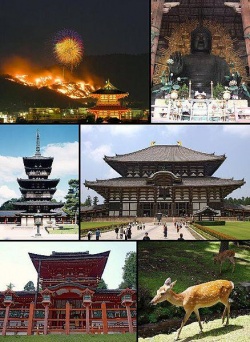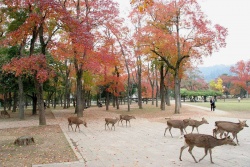Nara, Nara
Nara (奈良市 Nara-shi?) is the capital city of Nara Prefecture located in the Kansai region of Japan. The city occupies the northern part of Nara Prefecture, directly bordering Kyoto Prefecture. Eight temples, shrines and ruins in Nara, specifically Tōdai-ji, Saidai-ji, Kōfuku-ji, Kasuga Shrine, Gangō-ji, Yakushi-ji, Tōshōdai-ji, and the Heijō Palace remain, together with Kasugayama Primeval Forest, collectively form "Historic Monuments of Ancient Nara", a UNESCO World Heritage Site.
Etymology
According to the year 720 Japanese book Nihon Shoki the name "Nara" derived from the Japanese verb narasu "to flatten" and Nara is located in the flat Nara Basin (ja:奈良盆地). This is a folk etymology with other examples found in plenty throughout the text. Modern linguists suggest that it is cognate with the modern Korean word nara "country, kingdom".
More specially, Modern Korean nara derives from Middle Korean narah, which in turn is from reconstructed Old Korean *narak. The initial na may be related to Old Goguryeo na "earth". The final -ra < -rah < -rak may be identified as meaning "land, territory" and is also seen in other geographical places such as Nara, Gara, and Silla, the last two of which where spelled with a final k- in Old Japanese (cf, Shiraki). Also, Nara was also written variously as 寧楽 and 乃楽, suggesting a reading of *naraku, also with a final k- ending.
History
See also: Nara Prefecture#History, Nara period, and Heijo Palace
Nara was the capital of Japan from 710 to 784, lending its name to the Nara period.
The temples of Nara, known collectively as the Nanto Shichi Daiji, remained powerful even beyond the move of the political capital to Heian-kyō in 794, thus giving Nara a synonym of Nanto (南都 "The Southern Capital"?).
In 2010, Nara celebrated the 1,300th anniversary of its ascension as Japan's imperial capital.
Modern Nara
In the modern age, as the seat of the prefectural government, Nara has developed into a local center of commerce and government. The city was officially incorporated on February 1, 1898.
Geography
The city of Nara lies in the north end of Nara Prefecture, directly bordering itself to Kyoto Prefecture in its north side. The city is 22.22 km from North to South, from East to West. As a result of the latest merger, effective April 1, 2005, that combined the villages of Tsuge and Tsukigase with the city of Nara, the city now borders Mie Prefecture directly to its east. The total area is 276.84 km².
The downtown of Nara is on the east side of the ancient Heijō Palace site, occupying the northern part of what was called the Gekyō (外京), literally the outer capital area. Many of the public offices (e.g. the Municipal office, the Nara Prefectural government, the Nara Police headquarters, etc.) are located on Nijō-ōji (二条大路), while Nara branch offices of major nationwide banks are on Sanjō-ōji (三条大路), with both avenues running east-west.
The highest point in the city is at the peak of Kaigahira-yama, alt.822.0 m (2,696.85 ft) (Tsugehayama-cho district), and the lowest is in Ikeda-cho district, with an altitude of 56.4 m (185.04 ft).
Climate
The climate of Nara Prefecture is generally temperate, although there are notable differences between the north-western basin area and the rest of the prefecture which is more mountainous.
The basin area climate has an inland characteristic, as represented in the higher daily temperature variance, and the difference between summer and winter temperatures. Winter temperatures average approximately 3 to 5 °C (37 to 41 °F), and from 25 to 28 °C (77 to 82 °F) in the summer with highest readings reaching close to 35 °C (95 °F). There has not been a single year since 1990 with more than 10 days of snowfall recorded by Nara Local Meteorological Observatory.
The climate in the rest of the prefecture is that of higher elevations especially in the south, with −5 °C (23 °F) being the extreme minimum in winter. Heavy rainfall is often observed in summer. The annual accumulated rainfall totals as much as 3,000 to 5,000 mm (118.11 to 196.85 in), which is among the heaviest in Japan and indeed in the world outside the equatorial zone.
Spring and fall temperatures are temperate and comfortable. The mountainous region of Yoshino has been long popular for viewing cherry blossoms in the spring. In autumn, the southern mountains are also a popular destination for viewing fall foliage.
Demographics
As of 2005, the city has an estimated population of 373,189 and a population density of 1,348 persons per km². There were 147,966 households residing in Nara. The highest concentration of both households and population, respectively about 46,000 and 125,000, is found along the newer bedtown districts, along the Kintetsu line connecting to Osaka. There were about 3,000 registered foreigners in the city, of which Koreans and Chinese are the two largest groups with about 1,200 and 800 people respectively. There were slightly fewer than 1,200 deer in Nara in 2005.
Landmarks
- Buddhist temples
- Tōdai-ji, including Nigatsu-dō
- Saidai-ji
- Kōfuku-ji
- Gangō-ji
- Yakushi-ji
- Tōshōdai-ji
- Shinyakushi-ji
- Daian-ji
- Enjō-ji
- Ryōsen-ji
- Shinto shrines
- Kasuga Shrine
- Former imperial palace
- Heijō Palace
- Others
- Kasugayama Primeval Forest
- Naramachi
- Nara National Museum
- Nara Park
- Nara Hotel
- Isuien Garden
- Sarusawa Pond
- Mount Wakakusa
- Yagyū
Deer in Nara
According to the legendary history of Kasuga Shrine, a mythological god Takemikazuchi arrived in Nara on a white deer to guard the newly built capital of Heijō-kyō. Since then the deer have been regarded as heavenly animals, protecting the city and the country.
Tame Sika Deer roam through the town, especially in Nara Park. Snack vendors sell "shika sembei" (deer biscuits) to visitors so they can feed the deer.
Education
As of 2005, there are 16 high schools and 6 universities located in the city of Nara.
Universities
Nara Women's University is one of only two national women's universities in Japan.
Primary and secondary education
Public schools
Public elementary and junior high schools are operated by the city of Nara.
Public high schools are operated by the Nara Prefecture.
Private schools
Private high schools in Nara include the Todaiji Gakuen, a private school founded by the temple in 1926.
International relations
See also: List of twin towns and sister cities in Japan
Twin towns/sister cities
Nara, according to its own official record, has three sister cities in Japan and six sister cities overseas.
In Japan
- Dazaifu, Fukuoka
- Kōriyama, Fukushima
- Obama, Fukui
Outside Japan
- Canberra, Australia
- Gyeongju, Korea
- Toledo, Castile-La Mancha, Spain
- Versailles, France
- Xi'an, China
- Yangzhou, China

